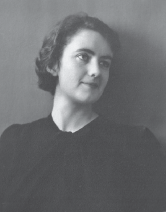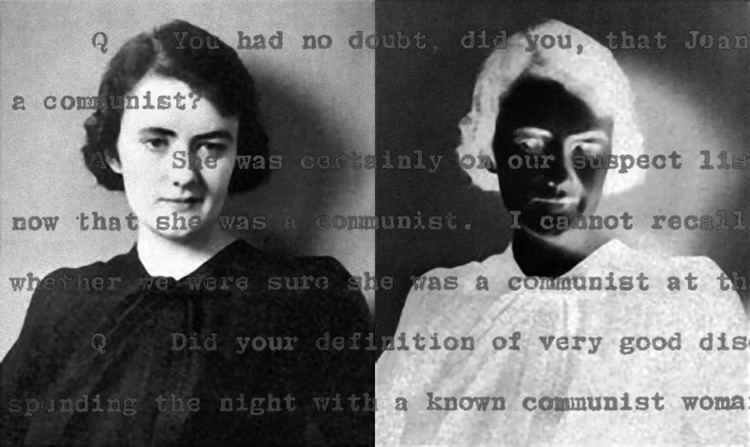Name Jean Tatlock | ||
 | ||
Died January 5, 1944, San Francisco, California, United States | ||
Chapter 12 jean tatlock
Jean Frances Tatlock (February 21, 1914 – January 4, 1944) was an American psychiatrist and physician. She was a member of the Communist Party of America and was a reporter and writer for the party's publication Western Worker. She is most widely known for her romantic relationship with Robert Oppenheimer, the director of the Manhattan Project's Los Alamos Laboratory during World War II.
Contents

The daughter of John Strong Perry Tatlock, a prominent Old English philologist and an expert on Geoffrey Chaucer, Tatlock was a graduate of Vassar College and the Stanford Medical School, where she studied to become a psychiatrist. Tatlock began seeing Oppenheimer in 1936, when she was a graduate student at Stanford and Oppenheimer was a professor of physics at the University of California, Berkeley. As a result of their relationship and her membership of the Communist Party, she was placed under surveillance by the FBI, and her phone was tapped.

She suffered from clinical depression and committed suicide on January 4, 1944.

Early life

Jean Frances Tatlock was born in Ann Arbor, Michigan, on February 21, 1914, the second child of John Strong Perry Tatlock and his wife Marjorie née Fenton. She had an older brother named Hugh, who became a physician. Her father, who had a Ph.D. from Harvard University, was a noted and acclaimed professor of English at the University of Michigan; an Old English philologist; an expert on Geoffrey Chaucer and English plays, poems, and Elizabethan era literature; and author of approximately 60 books on those subjects, including The Complete Poetical Works of Geoffrey Chaucer (1912) and The Mind and Art of Chaucer (1950). John Tatlock was a professor of English at Stanford from 1915 to 1925, and Harvard from 1925 to 1929, before returning to the Bay Area as a professor of English at the University of California, Berkeley.
Tatlock attended Cambridge Rindge and Latin School in Cambridge, Massachusetts, and Williams College in Berkeley. In 1930, she entered Vassar College. She graduated in 1935, and returned to Berkeley, where she took courses to complete the prerequisites for Stanford Medical School, and was a reporter and writer for the Western Worker, the Communist Party of America's organ on the West Coast of the United States. She was accepted into Stanford Medical School (then located in San Francisco), where she studied to become a psychiatrist. She graduated from Stanford with the class of 1941, and completed her internship at St. Elizabeths Hospital in Washington, D.C., and residency at the Department of Psychiatry at Mount Zion Hospital (now the University of California, San Francisco Medical Center) in San Francisco.
Romance with Oppenheimer
Tatlock struggled with her sexuality, at one point writing to a friend that "there was a period when I thought I was homosexual. I still am, in a way, forced to believe it, but really, logically, I am sure that I can't be because of my un-masculinity." She began seeing Robert Oppenheimer in 1936, when she was a graduate student there and Oppenheimer was a professor of physics at Berkeley. They met through his landlady, Mary Ellen Washburn, who was also a member of the Communist party, when Washburn held a fund raiser for communist-backed Spanish Republicans. The couple started dating and had a passionate relationship; he proposed to her twice, but she refused. She is credited with introducing Oppenheimer to radical politics during the late 1930s, and to people involved with, or sympathetic to the Communist Party or related groups, such as Rudy Lambert and Thomas Addis. They continued seeing each other after he became involved with Kitty Harrison, whom he married on November 1, 1940. Oppenheimer and Tatlock spent the New Year together in 1941, and once met at Mark Hopkins hotel in San Francisco.
Oppenheimer's association with her friends was used as evidence against him during his 1954 security hearing. In a letter to Major General Kenneth D. Nichols, General Manager, United States Atomic Energy Commission, dated March 4, 1954, Oppenheimer described their association as follows:
In the spring of 1936, I had been introduced by friends to Jean Tatlock, the daughter of a noted professor of English at the university; and in the autumn, I began to court her, and we grew close to each other. We were at least twice close enough to marriage to think of ourselves as engaged. Between 1939 and her death in 1944 I saw her very rarely. She told me about her Communist Party memberships; they were on again, off again affairs, and never seemed to provide for her what she was seeking. I do not believe that her interests were really political. She loved this country and its people and its life. She was, as it turned out, a friend of many fellow travelers and Communists, with a number of whom I was later to become acquainted.
I should not give the impression that it was wholly because of Jean Tatlock that I made leftwing friends, or felt sympathy for causes which hitherto would have seemed so remote from me, like the Loyalist cause in Spain, and the organization of migratory workers. I have mentioned some of the other contributing causes. I liked the new sense of companionship, and at the time felt that I was coming to be part of the life of my time and country.
While some historians believe that Oppenheimer had an extramarital affair with Tatlock while he was working on the Manhattan Project, others assert he met with Tatlock only once after he was picked to head the Los Alamos Laboratory in mid-June 1943. On June 14, 1943, Oppenheimer was in Berkeley to recruit David Hawkins as an administrative assistant. They went to a Mexican restaurant in her green 1935 Plymouth coupe, and spent the night together at her San Francisco apartment at 1405 Montgomery Street. All the while, U.S. Army agents, waiting in the street outside, had them under surveillance. At that meeting she told him that she still loved him and wanted to be with him. He never saw her again.
Death
Tatlock suffered from severe clinical depression, and was being treated at Mount Zion. At around 1 pm on January 5, 1944, her father arrived at her apartment at 1405 Montgomery Street. When there was no response to his ringing the doorbell, he climbed in through a window. He found her dead, lying on a pile of cushions in the bathroom, with her head submerged in the partly-filled bathtub. There was an unsigned suicide note, which read:
I am disgusted with everything... To those who loved me and helped me, all love and courage. I wanted to live and to give and I got paralyzed somehow. I tried like hell to understand and couldn't... I think I would have been a liability all my life—at least I could take away the burden of a paralyzed soul from a fighting world.
Her father found her correspondence and sifted through it, burning letters and photographs in the fireplace. At 5:10 pm he called the Halstead Funeral Home, who contacted the police. The police arrived at 5:30 pm, accompanied by the deputy coroner. At the time of her death she was under surveillance by the FBI, and her phone had been tapped, so one of the first people informed about it was FBI director J. Edgar Hoover, via a teletype link. The news of her death was reported in Bay Area newspapers.
Washburn cabled Charlotte Serber at Los Alamos. As the librarian, she had access to the Technical Area, and told her husband, physicist Robert Serber, who then went to inform Oppenheimer. When he reached his office, he found that Oppenheimer already knew. The security chief at Los Alamos, Captain Peer de Silva, had received the news through the wiretap and Army Intelligence, and had broken it to Oppenheimer. Tatlock had introduced Oppenheimer to the poetry of John Donne, and it is widely believed he named the first test of a nuclear weapon "Trinity" in reference to one of Donne's poems, as a tribute to her. In 1962, Leslie Groves wrote to Oppenheimer about the origin of the name, and elicited this reply:
I did suggest it... Why I chose the name is not clear, but I know what thoughts were in my mind. There is a poem of John Donne, written just before his death, which I know and love. From it a quotation:
As West and EastIn all flatt Maps—and I am one—are one,So death doth touch the Resurrection.In another, better known devotional poem Donne opens,
Batter my heart, three person'd God.A formal inquest in February 1944 returned a verdict of "Suicide, motive unknown". In his report, the coroner found that Tatlock had eaten a full meal shortly before her death. She had taken some barbiturates, but not a fatal dose. Traces of chloral hydrate were found, a drug normally associated with a "Mickey Finn" when combined with alcohol, but there was no alcohol in her blood, despite damage to her pancreas that indicated she was a heavy drinker. As a psychiatrist working in a hospital, she had access to sedatives such as chloral hydrate. The coroner found that she had died at around 4:30 pm on January 4. The cause of death was recorded as "acute edema of the lungs with pulmonary congestion" — drowning in the bathtub. It seems likely that she knelt over the bathtub, took chloral hydrate, and plunged her head in the water.
There has been, at times, speculation by historians and her brother Hugh as to whether her death was truly a suicide, as there were some suspicious circumstances. The theory suggesting her assassination by intelligence operatives associated with the Manhattan Project gained traction following the 1975 Church Committee revelations. This committee exposed various assassinations executed by American intelligence agencies, a theme fictionalized in the TV series "Manhattan." A medical professional noted, "If you were clever and wished to kill someone, this method would be ideal."
Her father had her remains cremated.
